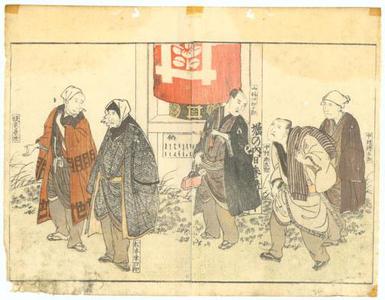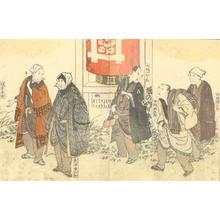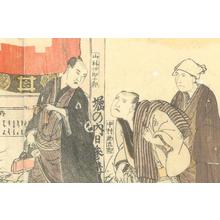Artist: Utagawa Toyokuni I
Title: Amusements of Actors on the Third Floor
Date: 1801
Details & Prices: More information...
Source:
Robyn Buntin of Honolulu
Browse all 4,310 prints...
Description:
Classic illustration for picture book entitled Yakusha Sankai-kyo (Amusements of the Actors on the Third Floor). Here is an excerpt from Jack Hillier, "The Art of the Japanese Book", pp.578-580: But Toyokuni's books were not confined to portraiture. He knew the public craving for intimate views of the lives of the actors off-stage and back-stage as well as for pictures of them performing, and the Yakusha Sankai-kyo (Amusements of the Actors on the Third Floor), of 1801, was intended to satisfy this obsessive curiosity, of a kind which has always persisted, in the west as well as in Japan, in regard to entertainers in the public eye. The "Third Floor" is the "Green Room", and represents a rare example of the Tokugawa authorities tacitly accepting a violation of their regulations. Three-storey buildings were prohibited for theatres out of respect for public safety, but generally there was a building of that height at the back of the stage, used as the actors' dressing-room. The theatre owners argued that it was necessary to have the dressing-room of those playing male and female roles (though they were all played by men) on separate floors, and by the subterfuge of calling the second and third floors the "middle second floor" and the "main second floor", succeeded in evading the law. In the book, actors of both male and female roles are depicted not merely in the dressing-room, but out and about in Edo. Shikitei Samba provided an introduction and a text that is lively and informed - there is even an amusing portrait of him as frontispiece, seated in a throne-like chair and wearing priestly robes, as if he were indeed the tutelary genius of Kabuki. The actors are sometimes shown in predicaments that arose from their notoriety: as being unable to avoid popular adulation, or to find privacy where they might enjoy being incognito. The two volumes explore the ways in which they spent their leisure. In the first, we see parties of them parading in New Year ceremonial attire; visiting the Yoshiwara and feted by the denizens; seeking the quiet of a beach where fishermen are trawling; enjoying a meal on the balcony of a restaurant at the time of cherry-blossom; taking an outing on a pleasure-boat; spending an evening playing the shamisen; and, on a winter's evening, listening to a recitation of verse. Similar scenes of recreation and indulgence in licensed houses and restaurants [377] form the main contents of the second volume, but there is also an interesting and crowded scene of a dress rehearsal of a play; a picture of Ichikawa Hakuen inscribing a paper lantern for Arashi Hinasuke, who is kneeling obsequiously before him; and another of five actors, making their way to an engagement perhaps, and about to cross a bridge in the pouring rain [378].



